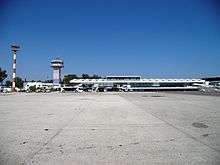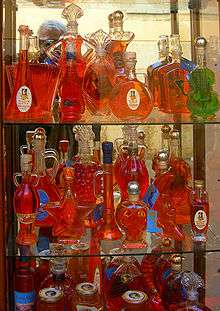Corfu
| Corfu Κέρκυρα | |
|---|---|
|
Pontikonisi (background) and Vlacherna Monastery (foreground) seen from the hilltops of Kanoni | |
 Corfu | |
|
Location within the region 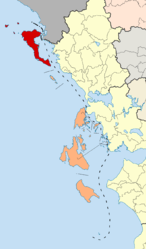 | |
| Coordinates: 39°35′N 19°52′E / 39.583°N 19.867°ECoordinates: 39°35′N 19°52′E / 39.583°N 19.867°E | |
| Country | Greece |
| Administrative region | Ionian Islands |
| Regional unit | Corfu |
| Government | |
| • Mayor | Konstantinos Nikolouzos[1] |
| Area | |
| • Municipality | 610.9 km2 (235.9 sq mi) |
| Highest elevation | 906 m (2,972 ft) |
| Lowest elevation | 0 m (0 ft) |
| Population (2011)[2] | |
| • Municipality | 102,071 |
| • Municipality density | 170/km2 (430/sq mi) |
| Time zone | EET (UTC+2) |
| • Summer (DST) | EEST (UTC+3) |
| Postal code | 490 82, 490 83, 490 84, 491 00 |
| Area code(s) | 26610, 26620, 26630 |
| Vehicle registration | KY |
| Website | www.corfu.gr |

Corfu (/kɔːrˈfuː, -fjuː/; Greek: Κέρκυρα, Kérkyra [ˈcercira]; Ancient Greek: Κέρκυρα or Κόρκυρα; Latin: Corcyra; Italian: Corfù) is a Greek island in the Ionian Sea. It is the second largest of the Ionian Islands,[3] and, including its small satellite islands, forms the northwesternmost part of Greece.[4] The island is part of the Corfu regional unit, and is administered as a single municipality, which also includes the smaller islands of Ereikoussa, Mathraki and Othonoi. The municipality has an area of 610.936 km2, the island proper 592.877 km2.[5] The principal city of the island and seat of the municipality (pop. 32,095) is also named Corfu.[6] Corfu is home to the Ionian University.
The island is bound up with the history of Greece from the beginnings of Greek mythology. Its history is full of battles and conquests. Castles punctuating strategic locations across the island are a legacy of these struggles. Two of these castles enclose its capital, which is the only city in Greece to be surrounded in such a way. As a result, Corfu's capital has been officially declared a Kastropolis ("castle city") by the Greek government.[7] From medieval times and into the 17th century, the island was recognised as a bulwark of the European States against the Ottoman Empire and became one of the most fortified places in Europe.[8] The fortifications of the island were used by the Venetians to defend against Ottoman intrusion into the Adriatic. Corfu repulsed several Ottoman sieges, before falling under British rule following the Napoleonic Wars. Corfu was eventually ceded by the British Empire along with the remaining islands of the United States of the Ionian Islands, and unification with modern Greece was concluded in 1864 under the Treaty of London.
In 2007, the city's old quarter was added to the UNESCO World Heritage List, following a recommendation by ICOMOS.[9][10][11]
Corfu is a very popular tourist destination.[12][13] The island was the location of the 1994 European Union summit.[14]
Name
The Greek name, Kerkyra or Korkyra, is related to two powerful water deities: Poseidon, god of the sea, and Asopos, an important Greek mainland river.[15] According to myth, Poseidon fell in love with the beautiful nymph Korkyra, daughter of Asopos and river nymph Metope, and abducted her.[15] Poseidon brought Korkyra to the hitherto unnamed island and, in marital bliss, offered her name to the place: Korkyra,[15] which gradually evolved to Kerkyra (Doric).[7] They had a child they called Phaiax, after whom the inhabitants of the island were named Phaiakes, in Latin Phaeaciani. Corfu's nickname is the island of the Phaeacians.
The name Corfù, an Italian version of the Byzantine Κορυφώ (Koryphō), meaning "city of the peaks", derives from the Byzantine Greek Κορυφαί (Koryphai) (crests or peaks), denoting the two peaks of Palaio Frourio.[7]
Geography

The northeastern edge of Corfu lies off the coast of Sarandë, Albania, separated by straits varying in width from 3 to 23 km (2 to 14 miles). The southeast side of the island lies off the coast of Thesprotia, Greece. Its shape resembles a sickle (drepanē, δρεπάνι), to which it was compared by the ancients: the concave side, with the city and harbour of Corfu in the centre, lies toward the Albanian coast. With the island's area estimated at 592.9 square kilometres (146,500 acres),[5] it runs approximately 64 km (40 mi) long, with greatest breadth at around 32 km (20 mi).
Two high and well-defined ranges divide the island into three districts, of which the northern is mountainous, the central undulating, and the southern low-lying. The more important of the two ranges, that of Pantokrator (Παντοκράτωρ – the Almighty) stretches east and west from Cape Falacro to Cape Psaromita, and attains its greatest elevation in the summit of the same name.
The second range culminates in the mountain of Santi Jeca, or Santa Decca, as it is called by misinterpretation of the Greek designation Άγιοι Δέκα (Hagioi Deka), or the Ten Saints. The whole island, composed as it is of various limestone formations, presents great diversity of surface, and views from more elevated spots are magnificent. Beaches are found in Agios Gordis, the Korission lagoon, Agios Georgios, Marathia, Kassiopi, Sidari, Palaiokastritsa and many others. Corfu is located near the Kefalonia geological fault formation; earthquakes have occurred.
Corfu's coastline spans 217 kilometres (135 mi) including capes; its highest point is Mount Pantokrator (911 metres (2,989 ft)); and the second Stravoskiadi, at 849 m (2,785 ft). The full extent of capes and promontories take in Agia Aikaterini, Drastis to the north, Lefkimmi and Asprokavos to the southeast, and Megachoro to the south. Two islands are also to be found at a middle point of Gouvia and Corfu Bay, which extends across much of the eastern shore of the island; are known as Lazareto and Ptychia (or Vido). Camping areas can be found in Palaiokastritsa, Agrillia, with four in the northern part, Pyrgi, Roda, Gouvia and Messonghi.
Diapontia islands
The Diapontia Islands (Greek: Διαπόντια νησιά) are located in the northwest of Corfu, (6 km away) and about 40 km away from Italian coasts. The main islands are Othonoi, Ereikoussa and Mathraki.
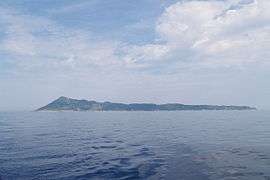
Lazaretto Island
Lazaretto Island, formerly known as Aghios Dimitrios, is located two nautical miles northeast of Corfu; the island has an area of 17.5 acres and comes under the administration of the Greek National Tourist Organization. During Venetian rule in the early 16th century, a monastery was built on the islet and a leprosarium established later in the century, after which the island was named. In 1798, during the French occupation, the islet was occupied by the Russo-Turkish fleet, who ran it as a military hospital. During the British occupation, in 1814, the leprosarium was once again opened after renovations, and following Enosis in 1864 the leprosarium again saw occasional use.[16] During World War II, the Axis Occupation of Greece established a Nazi concentration camp there for the prisoners of the Greek Resistance movement,[17] while remaining today are the two-storied building that served as the Headquarters of the Italian army, a small church, and the wall against which those condemned to death were shot.[16][17]
Flora
Homer identifies seven plants that adorn the garden of Alcinous: wild olive, pear, pomegranate, apple, fig and grape vine. Of these the apple and the pear are (as of 2011) very inferior in Corfu; the others thrive, together with all the fruit trees known in southern Europe, with addition of the kumquat, loquat and prickly pear and, in some spots, the banana. When undisturbed by cultivation, the myrtle, arbutus, bay and holm oak form a rich brushwood, along with fir and Turkey oak in the hills. The minor flora of the island are extensive.
Climate
Corfu has a hot-summer Mediterranean climate (Csa in the Koeppen climate classification).
| Climate data for Corfu | |||||||||||||
|---|---|---|---|---|---|---|---|---|---|---|---|---|---|
| Month | Jan | Feb | Mar | Apr | May | Jun | Jul | Aug | Sep | Oct | Nov | Dec | Year |
| Record high °C (°F) | 20.5 (68.9) |
22.4 (72.3) |
26.0 (78.8) |
28.0 (82.4) |
33.8 (92.8) |
35.6 (96.1) |
42.4 (108.3) |
40.0 (104) |
37.4 (99.3) |
31.0 (87.8) |
25.0 (77) |
22.0 (71.6) |
42.4 (108.3) |
| Average high °C (°F) | 13.9 (57) |
14.2 (57.6) |
16.0 (60.8) |
19.0 (66.2) |
23.8 (74.8) |
28.0 (82.4) |
30.9 (87.6) |
31.3 (88.3) |
27.6 (81.7) |
23.2 (73.8) |
18.7 (65.7) |
15.3 (59.5) |
21.8 (71.2) |
| Daily mean °C (°F) | 9.7 (49.5) |
10.3 (50.5) |
12.0 (53.6) |
14.9 (58.8) |
19.6 (67.3) |
23.9 (75) |
26.4 (79.5) |
26.3 (79.3) |
22.7 (72.9) |
18.4 (65.1) |
14.3 (57.7) |
11.1 (52) |
17.5 (63.5) |
| Average low °C (°F) | 5.1 (41.2) |
5.7 (42.3) |
6.8 (44.2) |
9.2 (48.6) |
12.9 (55.2) |
16.4 (61.5) |
18.4 (65.1) |
18.8 (65.8) |
16.5 (61.7) |
13.4 (56.1) |
9.9 (49.8) |
6.8 (44.2) |
11.7 (53.1) |
| Record low °C (°F) | −4.5 (23.9) |
−4.2 (24.4) |
−4.4 (24.1) |
0.0 (32) |
4.6 (40.3) |
8.7 (47.7) |
10.0 (50) |
11.3 (52.3) |
7.2 (45) |
2.8 (37) |
−2.2 (28) |
−2.0 (28.4) |
−4.5 (23.9) |
| Average rainfall mm (inches) | 136.6 (5.378) |
124.6 (4.906) |
98.1 (3.862) |
66.7 (2.626) |
37.0 (1.457) |
14.1 (0.555) |
9.2 (0.362) |
19.0 (0.748) |
81.3 (3.201) |
137.7 (5.421) |
187.4 (7.378) |
185.6 (7.307) |
1,097.3 (43.201) |
| Average rainy days | 16.1 | 14.6 | 14.5 | 12.9 | 8.0 | 4.9 | 2.3 | 3.4 | 7.0 | 11.8 | 15.7 | 17.5 | 128.7 |
| Average relative humidity (%) | 75.4 | 74.3 | 73.4 | 72.8 | 69.5 | 63.4 | 60.0 | 62.2 | 70.4 | 74.6 | 77.5 | 77.2 | 70.7 |
| Mean monthly sunshine hours | 117.7 | 116.8 | 116.0 | 206.5 | 276.8 | 324.2 | 364.5 | 332.8 | 257.1 | 188.9 | 133.5 | 110.9 | 2,545.7 |
| Source #1: Hellenic National Meteorological Service[18] | |||||||||||||
| Source #2: NOAA (extremes and sun 1961−1990)[19] | |||||||||||||
History
Early history
The earliest reference to Corfu is the Mycenaean Greek word ko-ro-ku-ra-i-jo ("man from Kerkyra") written in Linear B syllabic script, c. 1300 BC.[20] According to Strabo Corcyra (Κόρκυρα) was the Homeric island of Scheria (Σχερία),[21] and its earliest inhabitants were the Phaeacians (Φαίακες). The island has indeed been identified by some scholars with Scheria, the island of the Phaeacians described in Homer's Odyssey, though conclusive and irrefutable evidence for this theory or for Ithaca's location have not been found. Apollonius of Rhodes depicts the island in Argonautica as a place visited by the Argonauts. Jason and Medea were married there in 'Medea's Cave'. Apollonius named the island Drepane, Greek for "sickle", since it was thought to hide the sickle that Cronus used to castrate his father Uranus, from whose blood the Phaeacians were descended. In an alternative account, Apollonius identifies the buried sickle as a scythe belonging to Demeter, yet the name Drepane probably originated in the sickle-shape of the island. According to a scholiast, commenting on the passage in Argonautica, the island was first of all called Macris after the nurse of Dionysus who fled there from Euboea.[22]
Other have asserted that Corfu was Taphos, the island of the lelegian Taphians.[23]
At a date no doubt previous to the foundation of Syracuse, Corfu was peopled by settlers from Corinth, probably 730 BC, but it appears to have previously received a stream of emigrants from Eretria. The commercially advantageous location of Corcyra on the way between Greece and Magna Grecia, and its fertile lowlands in the southern section of the island favoured its growth and, influenced perhaps by the presence of non-Corinthian settlers, its people, quite contrary to the usual practice of Corinthian colonies, maintained an independent and even hostile attitude towards the mother city.
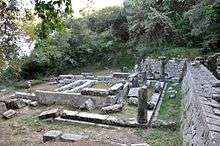
This opposition came to a head in the early part of the 7th century BC, when their fleets fought the first naval battle recorded in Greek history: 665 BC according to Thucydides. These hostilities ended in the conquest of Corcyra by the Corinthian tyrant Periander (Περίανδρος) who induced his new subjects to join in the colonization of Apollonia and Anactorium. The island soon regained its independence and thenceforth devoted itself to a purely mercantile policy. During the Persian invasion of 480 BC it manned the second largest Greek fleet (60 ships), but took no active part in the war. In 435 BC it was again involved in a quarrel with Corinth over the control of Epidamnus, and sought assistance from Athens (see Battle of Sybota).
This new alliance was one of the chief immediate causes of the Peloponnesian War, in which Corcyra was of considerable use to the Athenians as a naval station, but did not render much assistance with its fleet. The island was nearly lost to Athens by two attempts of the oligarchic faction to effect a revolution; on each occasion the popular party ultimately won the day and took a most bloody revenge on its opponents (427 BC and 425 BC).[24]
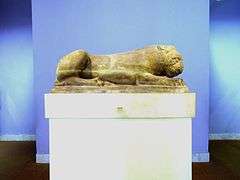
During the Sicilian campaigns of Athens Corcyra served as a supply base; after a third abortive rising of the oligarchs in 410 BC it practically withdrew from the war. In 375 BC it again joined the Athenian alliance; two years later it was besieged by a Spartan force, but in spite of the devastation of its flourishing countryside held out successfully until relieved. In the Hellenistic period Corcyra was exposed to attack from several sides.
In 303 BC, after a vain siege by Cassander, the island was occupied for a short time by the Lacedaemonian general Cleonymus of Sparta, then regained its independence and later it was attacked and conquered by Agathocles. He offered Corfu as dowry to his daughter Lanassa on her marriage to Pyrrhus, King of Epirus. The island then became a member of the Epirotic alliance. It was then perhaps that the settlement of Cassiope was founded to serve as a base for the King of Epirus' expeditions. The island remained in the Epirotic alliance until 255 BC when it became independent after the death of Alexander, last King of Epirus. In 229 BC, following the naval battle of Paxos, it was captured by the Illyrians, but was speedily delivered by a Roman fleet and remained a Roman naval station until at least 189 BC. At this time, it was governed by a prefect (presumably nominated by the consuls), but in 148 BC it was attached to the province of Macedonia.[25] In 31 BC, it served Octavian (Augustus) as a base against Mark Antony. From AD 336 onwards, it was ruled by the Eastern Roman Empire. After the definitive division of the Roman Empire in AD 395, Kerkyra remained with the Eastern Roman Empire, known in modern historiography as the Byzantine Empire.
Medieval history

Eclipsed by the foundation of Nicopolis, Kerkyra for a long time passed out of notice. With the rise of the Norman kingdom in Sicily and the Italian naval powers, it again became a frequent object of attack. In 1081–1085 it was held by Robert Guiscard, in 1147–1154 by Roger II of Sicily.
During the break-up of the Byzantine Empire the island was occupied by Genoese privateers (1197–1207), who in turn were expelled by the Venetians. In 1214 it passed to the Greek despots of Epirus, who gave it to Manfred of Sicily as a dowry in 1259.[26] At his death in 1267 it passed with his other possessions to the house of Anjou. Under the latter, the island suffered considerably from the inroads of various adventurers.
The island was one of the first places in Europe in which Romani people ("Gypsies") settled. In about 1360, a fiefdom, called the Feudum Acinganorum was established, with mainly Romani serfs.[27][28]
From 1386, Corfu was controlled by the Republic of Venice, which in 1401 acquired formal sovereignty and retained it until the French Occupation of 1797.
Venetian rule
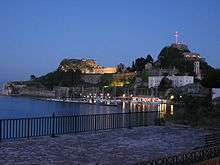
From medieval times and into the 17th century, the island was recognised as a bulwark of the European States against the Ottoman Empire and became one of the most fortified places in Europe.[8] The fortifications of the island were used by the Venetians to defend against Ottoman intrusion into the Adriatic. Corfu repulsed several Ottoman sieges, before passing under British rule following the Napoleonic Wars.[29][30][31][32][33][34][35]
Kerkyra, the "Door of Venice" during the centuries when the whole Adriatic was the Gulf of Venice,[36] remained in Venetian hands from 1401 until 1797, though several times assailed by Ottoman naval and land forces and subjected to four notable sieges in 1537, 1571, 1573 and 1716, in which the strength of the city defences asserted itself time after time. The effectiveness of the powerful Venetian fortifications as well as the strength of some old Byzantine castles in Angelokastro, Kassiopi Castle, Gardiki and elsewhere, were additional factors that enabled Corfu to remain free. Will Durant claims that Corfu owed to the Republic of Venice the fact that it was one of the few parts of Greece never conquered by the Ottomans.[37]
A series of attempts by the Ottomans to take the island began in 1431 when Ottoman troops under Ali Bey landed on the island. The Ottomans tried to take the city castle and raided the surrounding area, but were repulsed.[38]
.jpg)
The Siege of Corfu (1537) was the first great siege by the Ottomans. It began on 29 August 1537, with 25,000 soldiers from the Ottoman fleet landing and pillaging the island and taking 20,000 hostages as slaves. Despite the destruction wrought on the countryside, the city castle held out in spite of repeated attempts over twelve days to take it, and the Turks left the island unsuccessfully because of poor logistics and an epidemic that decimated their ranks.[38]
Thirty-four years later, in August 1571, Ottoman forces returned for yet another attempt to conquer the island. Having seized Parga and Mourtos from the Greek mainland side, they attacked the Paxi islands. Subsequently they landed on Corfu's southeast shore and established a large beachhead all the way from the southern tip of the island at Lefkimi to Ipsos in Corfu's eastern midsection. These areas were thoroughly pillaged as in past encounters. Nevertheless the city castle stood firm again, a testament to Corfiot-Venetian steadfastness as well as the Venetian castle-building engineering skills. It is also worth mentioning that another castle, Angelokastro (Greek: Αγγελόκαστρο meaning Angelo's Castle and named for its Byzantine owner Angelos Komnenos), situated on the northwest coast near Palaiokastritsa (Greek: Παλαιοκαστρίτσα meaning Old Castle place) and located on particularly steep and rocky terrain, a tourist attraction today, also held out.[38]
These defeats in the east and the west of the island proved decisive, and the Ottomans abandoned their siege and departed. Two years later they repeated their attempt. Coming from Africa after a victorious campaign, they landed in Corfu and wreaked havoc on rural areas. Following a counterattack by the Venetian-Corfiot forces, the Ottoman troops were forced to leave the city by way of the sea.[38]

The second great siege of Corfu took place in 1716, during the last Ottoman–Venetian War (1714–18). After the conquest of the Peloponnese in 1715, the Ottoman fleet appeared in Buthrotum opposite Corfu. On 8 July the Ottoman fleet, carrying 33,000 men, sailed to Corfu from Buthrotum and established a beachhead at Ipsos.[38] The same day, the Venetian fleet encountered the Ottoman fleet off the channel of Corfu and defeated it in the ensuing naval battle. On 19 July, after taking a few outlying forts, the Ottoman army reached the hills around the city of Corfu and laid siege to it. Despite repeated assaults and heavy fighting, the Ottomans were unable to breach the defences and were forced to raise the siege after 22 days. The 5,000 Venetians and foreign mercenaries, together with 3,000 Corfiotes, under the leadership of Count von der Schulenburg who commanded the defence of the island, were victorious once more.[7][38][40] The success was owed in no small part to the extensive fortifications, where Venetian castle engineering had proven itself once again against considerable odds. The repulse of the Ottomans was widely celebrated in Europe, Corfu being seen as a bastion of Western civilization against the Ottoman tide.[29][41] Today, however, this role is often relatively unknown or ignored, but was celebrated in Juditha triumphans by the Venetian composer Antonio Vivaldi.
Venetian policies and heritage
Corfu's urban architecture differs from that of other major Greek cities, because of Corfu's unique history. From 1386 to 1797, Corfu was ruled by Venetian nobility; much of the city reflects this era when the island belonged to the Republic of Venice, with multi-storied buildings on narrow lanes. The Old Town of Corfu has clear Venetian influence and is amongst the World Heritage Sites in Greece. It was in the Venetian period that the city saw the erection of the first opera house (Nobile Teatro di San Giacomo di Corfù) in Greece, but it was badly damaged during World War II by German artillery.
Many Venetian-speaking families settled in Corfu during these centuries; they were called Corfiot Italians, and until the second half of the 20th century the Veneto da mar was spoken in Corfu. During this time, the local Greek language assimilated a large number of Italian and Venetian words, many of which are still common today. The internationally renowned Venetian-born British photographer Felice Beato is thought to have spent much of his childhood in Corfu. Also many Italian Jews took refuge in Corfu during the Venetian centuries and spoke their own language (Italkian), a mixture of Hebrew-Italian in a Venetian or Apulian dialect with some Greek words.
Venetians promoted the Catholic Church during their four centuries of rule in Corfu. Today the majority of Corfiots are Greek Orthodox, but the small Catholic minority (5%), living harmoniously with the Orthodox community, owes its faith to these origins. These contemporary Catholics are mostly families who came from Malta, but also from Italy, and today the Catholic community numbers about 4,000 ( 2⁄3 of Maltese descent), who live almost exclusively in the Venetian "Citadel" of Corfu City. Like other native Greek Catholics, they celebrate Easter using the same calendar as the Greek Orthodox church. The Cathedral of St. James and St. Christopher in Corfu City is the see of the Roman Catholic Archdiocese of Corfu, Zakynthos and Cephalonia.
The island served also as a refuge for Greek scholars, and in 1732, it became the home of the first academy of modern Greece. A Corfu cleric and scholar, Nikephoros Theotokis (1732–1800) became renowned in Greece as an educator, and in Russia (where he moved later in his life) as an Orthodox archbishop.
The island's culture absorbed Venetian influence in a variety of ways; like other Ionian islands (see Cuisine of the Ionian islands), its local cuisine took in such elements and today's Corfiot cooking includes Venetian delicacies and recipes: "Pastitsada", deriving from the Venetian "Pastissada" (Italian: "Spezzatino") and the most popular dish in the island of Corfu, "Sofrito", "Strapatsada", "Savoro", "Bianco" and "Mandolato".
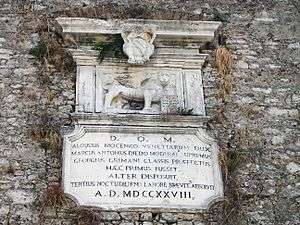
- Panoramic view of Corfu (city) from the New Fortress.
- Detail of the south wing of the entrance at Kassiopi Castle
- View of Kasiopi village from the castle
19th century
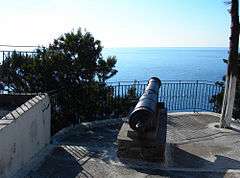
By the 1797 Treaty of Campo Formio, Corfu was ceded to the French, who occupied it for two years as the département of Corcyre, until they were expelled by a joint Russian-Ottoman squadron under Admiral Ushakov. For a short time it became the capital of a self-governing federation of the Heptanesos ("Seven Islands"), under Ottoman suzerainty; in 1807 after the Treaty of Tilsit its faction-ridden government was again replaced by a French administration under governor François-Xavier Donzelot, and in 1809 it was besieged in vain by a British fleet, which had taken all the other Ionian islands. When, by the Treaty of Paris of 5 November 1815, the Ionian Islands became a protectorate of the United Kingdom as the United States of the Ionian Islands, Corfu became the seat of the British Lord High Commissioner of the Ionian Islands. The period of British rule was a prosperous period for Corfu because the Greek language became official, new roads were built, the water supply system was improved and the first Greek university was founded in 1824. On 29 March 1864, the United Kingdom, Greece, France and Russia signed the Treaty of London, pledging the transfer of sovereignty to Greece upon ratification. Thus, on 21 May, by proclamation of the Lord High Commissioner, the Ionian Islands were united with Greece.[38]
British Lord High Commissioners
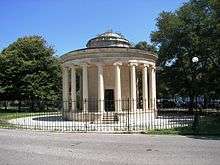
This is a list of the British High Commissioners of the Ionian Islands; (as well as the transitional Greek Governor, appointed a year prior to Enosis (Union) with Greece in 1864).[42]
- Sir James Campbell 1814–1816
- Sir Thomas Maitland (1759–1824) 1815–1823
- Sir Frederick Adam (1781–1853) 1823–1832
- Sir Alexander Woodford (1782–1870) 1832
- George Nugent-Grenville, 2nd Baron Nugent (1788–1850) 1832–1835
- Howard Douglas (1776–1861) 1835–1840
- James Alexander Stewart-Mackenzie (1784–1843) 1840–1843
- John Colborne, 1st Baron Seaton (1778–1863) 1843–1849
- Sir Henry George Ward (1797–1860) 1849–1855
- Sir John Young (1807–1876) 1855–1859
- William Ewart Gladstone (1809–1898) 1859
- Sir Henry Knight Storks (1811–1874) 1859–1863
- Count Dimitrios Nikolaou Karousos, President of Parliament (1799–1873) 1863–1864
First World War

During the First World War, the island served as a refuge for the Serbian army that retreated there on Allied forces' ships from a homeland occupied by the Austrians, Germans and Bulgarians. During their stay, a large portion of Serbian soldiers died from exhaustion, food shortage, and various diseases. Most of their remains were buried at sea near the island of Vido, a small island at the mouth of Corfu port, and a monument of thanks to the Greek nation has been erected at Vido by the grateful Serbs; consequently, the waters around Vido Island are known by the Serbian people as the Blue Tomb (in Serbian, Плава Гробница, Plava Grobnica), after a poem written by Milutin Bojić following World War I.[43]
Interwar period
In 1923, after a diplomatic dispute between Italy and Greece, Italian forces bombarded and occupied Corfu. The League of Nations settled this Corfu incident.
Second World War and resistance
Italian occupation

During the Greco-Italian War, Corfu was occupied by the Italians in April 1941. They administered Corfu and the Ionian islands as a separate entity from Greece until September 1943, following Benito Mussolini's orders of fulfilling Italian Irredentism and making Corfu part of the Kingdom of Italy. During the Second World War the 10th infantry regiment of the Greek Army, composed mainly of Corfiot soldiers,[44] was assigned the task of defending Corfu. The regiment took part in Operation Latzides, which was a heroic but ultimately unsuccessful attempt to stem the forces of the Italians.[44] After Greece's surrender to the Axis, the island came under Italian control and occupation.[44] On the first Sunday of November 1941, high school students from all over Corfu took part in student protests against the occupying Italian army; these student protests of the island were among the first acts of overt popular Resistance in occupied Greece and a rare phenomenon even by wartime European standards.[44] Subsequently, a considerable number of Corfiots escaped to Epirus in mainland Greece and enlisted as partisans in ELAS and EDES, in order to join the resistance movement gathering in the mainland.[44]
German occupation and the Holocaust

Upon the fall of Italian fascism in 1943, the Nazis moved to take control of the island. On 14 September 1943, Corfu was bombarded by the Luftwaffe; these bombing raids destroyed churches, homes, whole city blocks, especially in the Jewish quarter Evraiki, and a number of important buildings, such as the Ionian Parliament, the Municipal Theatre, the Municipal Library and others.[44] The Italians capitulated, and the island came under German occupation. Corfu's mayor at the time, Kollas, was a known collaborator and various anti-semitic laws were passed by the Nazis that now formed the occupation government of the island.[45] In early June 1944, while the Allies bombed Corfu as a diversion from the Normandy landings, the Gestapo rounded up the Jews of the city, temporarily incarcerated them at the old fort (Palaio Frourio), and on 10 June sent them to Auschwitz, where very few survived.[45][46] Approximately two hundred out of a total population of 1,900 escaped.[47] Many among the local population at the time provided shelter and refuge to those 200 Jews that managed to escape the Nazis.[48] A section of the old city is called Evraiki (Εβραική, meaning Jewish quarter), where there is currently a synagogue with about 65 members, who still speak their original Italkian language.[47]
Liberation
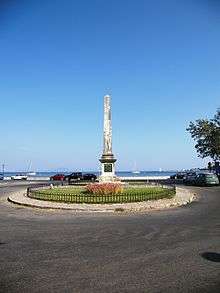
Corfu was liberated by British troops, specifically the 40th Royal Marine Commando, which landed in Corfu on 14 October 1944, as the Germans were evacuating Greece.[49] The Royal Navy swept the Corfu Channel for mines in 1944 and 1945, and found it to be free of mines.[50] A large minefield was laid there shortly afterwards by the newly communist Albania and gave rise to the Corfu Channel Incident.[50][51][52][53] This incident led to the Corfu Channel Case, where the United Kingdom opened a case against the People's Republic of Albania at the International Court of Justice.
Post–World War and modern Corfu
After World War II and the Greek Civil War, the island was rebuilt under the general programme of reconstruction of the Greek Government (Ανοικοδόμησις) and many elements of its classical architecture remain. Its economy grew but a portion of its inhabitants left the island for other parts of the country; buildings erected during Italian occupation – such as schools or government buildings – were put back to civic use. In 1956 Maria Desylla Kapodistria, relative of first Governor (head of state) of Greece Ioannis Kapodistrias, was elected mayor of Corfu and became the first female mayor in Greece.[54] The Corfu General Hospital was also constructed;[55] electricity was introduced to the villages in the 1950s, the radio substation of Hellenic Radio in Corfu was inaugurated in March 1957,[56] and television was introduced in the 1960s, with internet connections in 1995.[57] The Ionian University was established in 1984.
Urban landscape
Old town

The city of Corfu stands on the broad part of a peninsula, whose termination in the Venetian citadel (Greek: Παλαιό Φρούριο) is cut off from it by an artificial fosse formed in a natural gully, with a seawater moat at the bottom, that now serves as a marina and is called the Contrafossa. The old town, having grown within fortifications, where every metre of ground was precious, is a labyrinth of narrow streets paved with cobblestones, sometimes tortuous but colourful and clean. These streets are known as kantoúnia (Greek: καντούνια), and the older amongst them sometimes follow the gentle irregularities of the ground; while many are too narrow for vehicular traffic. A promenade rises by the seashore towards the bay of Garitsa (Γαρίτσα), together with an esplanade between the city and the citadel known as Spianada with the Liston arcade (Greek: Λιστόν) to its west side, where restaurants and bistros abound.[3]
Palaio Frourio

The old citadel (in Greek Palaio Frourio (Παλαιό Φρούριο) is an old Venetian fortress built on an artificial islet with fortifications surrounding its entire perimeter, although some sections, particularly on the east side, are slowly being eroded and falling into the sea. Nonetheless, the interior has been restored and is in use for cultural events, such as concerts (συναυλίες) and Sound and Light Productions (Ηχος και Φως), when historical events are recreated using sound and light special effects. These events take place amidst the ancient fortifications, with the Ionian sea in the background. The central high point of the citadel rises like a giant natural obelisk complete with a military observation post at the top, with a giant cross at its apex; at the foot of the observatory lies St. George's church, in a classical style punctuated by six Doric columns,[58] as opposed to the Byzantine architectural style of the greater part of Greek Orthodox churches.
Neo Frourio
.jpg)
The new citadel or Neo Frourio (Νέο Φρούριο, "New Fortress") is a huge complex of fortifications dominating the northeastern part of the city. The huge walls of the fortress loom over the landscape as one travels from Neo Limani (Νέο Λιμάνι, "New Port") to the city, taking the road that passes through the fishmarket (ψαραγορά). The new citadel was until recently a restricted area due to the presence of a naval garrison, but old restrictions have been lifted and it is now open to the public, with tours possible through the maze of medieval corridors and fortifications. The winged Lion of St Mark, the symbol of Venice, can be seen at regular intervals adorning the fortifications.
Ano and Kato Plateia and the music pavilion
Near the old Venetian Citadel a large square called Spianada is also to be found, divided by a street in two parts: "Ano Plateia" (literally: "Upper square") and "Kato Plateia" (literally: "Lower square"), (Ανω Πλατεία and Κάτω Πλατεία in Greek). This is the biggest square in South-Eastern Europe and one of the largest in Europe,[59][60] and replete with green spaces and interesting structures, such as a Roman-style rotunda from the era of British administration, known as the Maitland monument, built to commemorate Sir Thomas Maitland. An ornate music pavilion is also present, where the local "Philharmonikes" (Philharmonic Orchestras) (Φιλαρμονικές), mount classical performances in the artistic and musical tradition for which the island is well known. "Kato Plateia" also serves as a venue where cricket matches are held from time to time. In Greece, cricket is unique to Corfu, as it was once a British protectorate.
Palaia Anaktora and its gardens
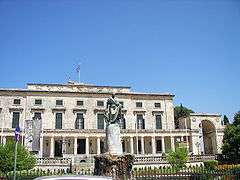

Just to the north of "Kato Plateia" lie the "Palaia Anaktora" (Παλαιά Ανάκτορα: literally "Old Palaces"): a large complex of buildings of Roman architectural style which formerly housed the Kings of Greece, and prior to that the British Governors of the island. It was then called the Palace of Saints Michael and George. The Order of St. Michael and St. George was founded here in 1818 with motto auspicium melioris aevi,[61][62] and is still awarded by the United Kingdom. Today the palace is open to the public and forms a complex of halls and buildings housing art exhibits, including a Museum of Asian Art, unique across Southern Europe in its scope and in the richness of its Chinese and Asian exhibits. The gardens of the Palaces, complete with old Venetian stone aquariums, exotic trees and flowers, overlook the bay through old Venetian fortifications and turrets, and the local sea baths (Μπάνια τ' Αλέκου) are at the foot of the fortifications surrounding the gardens. A café on the grounds includes its own art gallery, with exhibitions of both local and international artists, known locally as the Art Café. From the same spot, the viewer can observe ships passing through the narrow channel of the historic Vido island (Νησί Βίδου) to the north, on their way to Corfu harbour (Νέο Λιμάνι), with high speed retractable aerofoil ferries from Igoumenitsa also cutting across the panorama. A wrought-iron aerial staircase, closed to visitors, descends to the sea from the gardens; the Greek royal family used it as a shortcut to the baths. Rewriting history, locals now refer to the old Royal Gardens as the "Garden of the People" (Ο Κήπος του Λαού).
The Old Town and Pontikonisi
The Old Town of Corfu city is an UNESCO World Heritage Site. In several parts of the old city, buildings of the Venetian era are to be found. The old city's architectural character is strongly influenced by the Venetian style, coming as it did under Venetian rule for a long period; its small and ancient side streets, and the old buildings' trademark arches are particularly reminiscent of Venice. Of the thirty-seven Greek churches, the most important are the city's cathedral, the church dedicated to Our Lady of the Cave (η Παναγία Σπηλιώτισσα (hē Panagia Spēliōtissa)); Saint Spyridon church, wherein lies the preserved body of the patron saint of the island; and finally the suburban church of St Jason and St Sosipater (Αγιοι Ιάσων και Σωσίπατρος), reputedly the oldest in the island, and named after the two saints probably the first to preach Christianity to the Corfiots.
The nearby island, known as Pontikonisi (Greek meaning "mouse island"), though small is very green with abundant trees, and at its highest natural elevation (excluding its trees or man-made structures, such as the monastery), stands at about 2 m (6 ft 6.74 in). Pontikonisi is home of the monastery of Pantokrator (Μοναστήρι του Παντοκράτορος); the white stone staircase of the monastery, viewed from afar, gives the impression of a (mouse) tail, which lent the island its name.
Archaeology and architecture
An architectural overview: From classical to modern
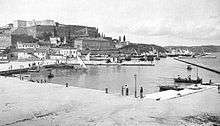
Corfu contains a few very important remains of antiquity. The site of the ancient city of Corcyra (Kerkyra) is well ascertained, about 1.5 mi (2 km) to the south-east of Corfu, upon the narrow piece of ground between the sea-lake of Halikiopoulo and the Bay of Castrades, in each of which it had a port. The circular tomb of Menekrates, with its well-known inscription, is on the Bay of Castrades. Under the hill of Ascension are the remains of a temple, popularly called of Poseidon, a very simple dome structure, which still in its mutilated state presents some peculiarities of architecture. In regard of Cassiope, the only other city of ancient importance, its name is still preserved by the village of Cassiopi, and there are some rude remains of building on the site; but the temple of Zeus Cassius for which it was celebrated has totally disappeared. Throughout the island numerous monasteries and other buildings of Venetian erection are to be found, of which the best known are Paleokastritsa, San Salvador and Peleka. The Achilleion is a palace commissioned by Elisabeth of Austria and purchased in 1907 by Wilhelm II of Germany; it is now a popular tourist attraction.
Italianate architecture

Corfu city is famous for its Italianate architecture, most notably the Liston, an arched colonnade lined with cafes on the edge of the Spianada (Esplanade), the vast main plaza and park which incorporates a cricket field and several pavilions. Also notable are the Venetian-Roman style City Hall, the Old and New castles, the recently restored Palace of Sts. Michael and George, formerly the residence of the British governor and the seat of the Ionian Senate, and the summer Palace of Mon Repos, formerly the property of the Greek royal family and birthplace of the Prince Philip, Duke of Edinburgh. The Park of Mon Repos is adjacent to the Palaiopolis of Kerkyra, where excavations were conducted by the Greek Archaeological Service in collaboration with the University of Louvain-la-Neuve in Belgium, and Brown University in the United States.
Examples of the finds can be found in the Museum of the Palace of Mon Repos.[63]
Destruction of architecture during World War II
During World War II, the island was bombed by the Luftwaffe, resulting in the destruction of most of the city's buildings, including its market (αγορά) and Hotel Bella Venezia. The worst architectural losses of the Luftwaffe bombardment were the splendid buildings of the Ionian Academy (Ιόνιος Ακαδημία), and the Municipal Theatre (which in 1901 had replaced the Nobile Teatro di San Giacomo). The Roman style Theatre (Θέατρον) of the city was later replaced by a bland, modern box-style building. Discussions have been held at local governmental level about demolishing this modern building and replacing it with a replica of the old theatre. In contrast, the Ionian University reconstructed the Ionian Academy in its former style.
The Achilleion
In 1889, Empress Elizabeth of Austria built a summer palace in the region of Gastouri (Γαστούρι) to the south of the city, naming it Achílleion (Αχίλλειον) after the Homeric hero Achilles. The structure is filled with paintings and statues of Achilles, both in the main hall and in the gardens, depicting scenes of the Trojan War. The palace, with the neoclassical Greek statues that surround it, is a monument to platonic romanticism as well as escapism.

The Imperial gardens on the hill look over the surrounding green hills and valleys and the Ionian sea. The centrepiece of the gardens is a marble statue on a high pedestal, of the mortally wounded Achilles (Greek: Αχιλλεύς Θνήσκων, Achilleús Thnēskōn, Achilles Dying) without hubris and wearing only a simple cloth and an ancient Greek hoplite helmet. This statue was carved by German sculptor Ernst Gustav Herter.
The hero is presented devoid of rank or status, and seems notably human though heroic, as he is forever trying to pull Paris's arrow from his heel. His classically depicted face is full of pain. He gazes skyward, as if to seek help from Olympus. According to Greek mythology, his mother Thetis was a goddess.
In 1898, Empress Sissi was assassinated at the age of 60 by an Italian anarchist, Luigi Lucheni, in Geneva, Switzerland. After her death, the palace was sold to the German Kaiser Wilhelm II. In contrast, at the great staircase in the main hall is a giant painting of the triumphant Achilles full of pride. Dressed in full royal military regalia and erect on his racing chariot, he pulls the lifeless body of Hector of Troy in front of the stunned crowd watching helplessly from inside the walls of the Trojan citadel.
Following the Kaiser's purchase of the Achilleion, he invited archaeologist Reinhard Kekulé von Stradonitz, a friend and advisor, to come to Corfu to advise him where to position the huge statue of Achilles which he commissioned. The famous salute to Achilles from the Kaiser, which had been inscribed at the statue's base, was also created by Kekulé. The inscription read:[64]
To the Greatest Greek from the Greatest German
The inscription was subsequently removed after World War II.[65]
The Achilleion was subsequently acquired by the Greek state and has now been converted into a museum.
Kaiser's Bridge
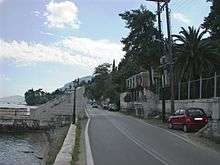
German Kaiser Wilhelm II was also fond of taking holidays in Corfu. Having purchased the Achilleion in 1907 after Sissi's death, he appointed Carl Ludwig Sprenger as the botanical architect of the Palace, and also built a bridge later named by the locals after him—the "Kaiser's bridge" (Greek: η γέφυρα του Κάιζερ transliterated as: i gefyra tou Kaizer) -- to access the beach without traversing the road forming the island's main artery to the south. The bridge, arching over the road, spanned the distance between the lower gardens of Achilleion and the nearby beach; its remains, a monument to imperial vanity, are an important landmark on the highway. The bridge's central section was demolished by the Wehrmacht in 1944, during the German occupation of World War II, to allow for the passage of an enormous cannon, forming part of the Nazi defences in the southeastern coast of Corfu.[66][67]
Municipality
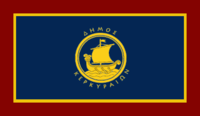
The present municipality of Corfu was formed in the 2011 local government reform by the merger of the following 15 former municipalities, which became municipal units:[6]
Province
The province of Corfu (Greek: Επαρχία Κέρκυρας) was one of the provinces of the Corfu Prefecture. Its territory corresponded with that of the current municipality Corfu.[68] It was abolished in 2006.
Education
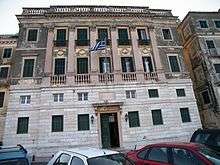
Aside from being a leading centre for the Fine Arts, Corfu is also the home of the Ionian Academy, an institution carrying through and strengthening the tradition of Greek education while the rest of Greece was still under Ottoman rule.
It is also home to the Ionian University, established in 1984, in recognition, by the administration of Andreas Papandreou, of Corfu's contribution to Education in Greece, as the seat of the first Greek university in modern times,[69] the Ionian Academy. The academy was founded in 1824, forty years before the cession of the Ionian islands to Greece, and just three years after Greece's Revolution of 1821.
Student activism
In the modern era, beginning with its massive student protests during World War II against fascist occupation, and continuing in the fight against the dictatorship of Georgios Papadopoulos (1967–1974), students in Corfu have played a vanguard role in protesting for freedom and democracy in Greece, against both internal and external oppression. For Corfiotes a recent example of such heroism is that of geology student Kostas Georgakis, who set himself ablaze in Genoa, Italy on 19 September 1970, in a protest against the Greek military junta of 1967-1974.
Culture
Museums and libraries
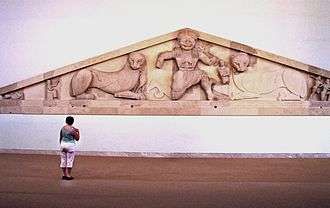
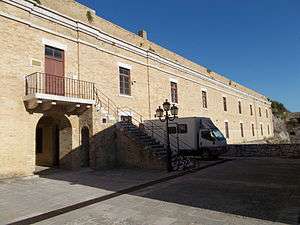
Kerkyra has always been a cultural centre of distinction and cosmopolitanism. Its museums and libraries are studded with irreplaceable books and artifacts. The most notable of its museums and libraries are located in the city, and are:[70]
- The Archaeological Museum, inaugurated in 1967, was constructed to house the exhibit of the huge Gorgon pediment of the Artemis temple in the ancient city of Korkyra, excavated at Palaiopolis in the early 20th century. The pediment has been described by the New York Times as the "finest example of archaic temple sculpture extant".[71] Kaiser Wilhelm II had developed a "lifelong obsession" with the Gorgon sculpture, dating from seminars on Greek Archaeology the Kaiser attended while at the University of Bonn. The seminars were given by archaeologist Reinhard Kekulé von Stradonitz, who later became the Kaiser's advisor.[64] In 1994, two more halls were added to the museum, where new discoveries from the excavations of the ancient city and the Garitsa cemetery are exhibited.
- The Museum of Asian art of Corfu is located at the Palace of St. Michael and St. George (mainly Chinese and Japanese Arts); its unique collection is housed in 15 rooms, taking in over 12,000 artifacts, including a Greco-Buddhist art collection that shows the influence of Alexander the Great on Buddhist culture as far as Pakistan (see Greco-Buddhism).
- The Banknote Museum, located in Aghios Spyridon square, features a complete collection of Greek banknotes from independence to the adoption of the euro in 2002.
- The Byzantine Museum of Antivouniotissa, a church converted into a museum featuring rare Byzantine art.
- Kapodistrias Museum. Ioannis Kapodistrias' summer home in Koukourisa in his birthplace of Corfu has been converted to a museum commemorating his life and accomplishments and has been named in his honour.[72] Donated by Maria Desylla Kapodistria, grand niece of Ioannis Kapodistrias, former mayor of Corfu and first female mayor of Greece.
- The Music Museum of the Philharmonic Society of Corfu is located in the building of the Philharmonic Society and features scores, instruments, paintings and documents related to the music history of Corfu and the 19th-century Ionian Islands.
- The Public Library of Corfu is located at the old English Barracks, in Palaio Frourio.
- The Reading Society of Corfu has an extensive library of old Corfu manuscripts and rare books.
- The Serbian Museum of Corfu (Serbian: Српска кућа, Serbian House) houses rare exhibits about the Serbian soldiers' tragic fate during the First World War. The remnants of the Serbian Army of about 150,000 soldiers together with their government in exile, found refuge and shelter in Corfu, following the collapse of the Serbian Front as a result of the Austro-Hungarian attack of 6 October 1915. Exhibits include photographs from the three years stay of the Serbians in Corfu, together with other exhibits such as uniforms, arms and ammunition of the Serbian army, Serbian regimental flags, religious artifacts, surgical tools and other decorations of the Kingdom of Serbia.
- Solomos Museum and the Corfiot Studies Society.
Patron Saint Spyridon
Saint Spyridon the Thaumaturgist (Miracle-worker, Θαυματουργός) is the patron saint (πολιούχος) of the city and the island. St. Spyridon is revered for the miracle of expelling the plague (πανώλη) from the island, among many other miracles attributed to him. It is believed by the faithful that on its way from the island the plague scratched one of the fortification stones of the old citadel to indicate its fury at being expelled; to St. Spyridon is also attributed the role of saving the island at the second great siege of Corfu of 1716.[73][74] The legend says that the sight of St. Spyridon approaching Ottoman forces bearing a flaming torch in one hand and a cross in the other caused panic.[38][75][76] The legend also states that the Saint caused a tempest which was partly responsible for repulsing the Ottomans.[77] This victory over the Ottomans, therefore, was attributed not only to the leadership of Count Schulenburg who commanded the stubborn defence of the island against Ottoman forces, but also to the miraculous intervention of St. Spyridon. Venice honoured von der Schulenburg and the Corfiots for successfully defending the island. Recognizing St. Spyridon's role in the defence of the island Venice legislated the establishment of the litany (λιτανεία) of St Spyridon on 11 August as a commemoration of the miraculous event, inaugurating a tradition that continues to this day.[38] In 1716 Antonio Vivaldi, on commission by the republic of Venice, composed the oratorio Juditha triumphans to commemorate this great event. Juditha triumphans was first performed in November 1716 in Venice by the orchestra and choir of the Ospedale della Pietà and is described as Vivaldi's first great oratorio.[78] Hence Spyridon is a very popular first name for Greek males born on the island and/or to islanders.
Music and festivities
The Three City Philharmonics
Corfiote musical tradition is significant. In the past, people would join in the singing of cantádes (Greek: καντάδες) or serenades), impromptu choral songs in two, three or four voices, usually accompanied by a guitar. Nowadays, in the face of rigours of a modern life from which Corfiote society has not been spared, cantádes (from the Italian verb cantare, to sing) are only performed by semi-professional or amateur singers, often as attractions for visitors.
'Bands' (Philharmonic societies, or Φιλαρμονικές), which also provide free instruction in music, are still popular and continue to attract young recruits. There are nineteen such marching wind bands throughout the island.
Corfu city is home to the three most prestigious bands – in order of seniority:
- the Philharmonic Society of Corfu use dark blue uniforms with dark red accents, and blue and red helmet plumes. It is usually called the Old Philharmonic or simply the Paliá ("Old"). Founded 12 September 1840.
- the Mantzaros Philharmonic Society use blue uniforms with blue and white helmet plumes. It is commonly called the Néa ("New"). Founded 25 October 1890.
- the Capodistria Philharmonic Union use bright red and black uniforms and plumes. It is commonly called the Cónte Capodístria or simply the Cónte ("Count"). It is the juniormost of the three (founded 18 April 1980).
All three maintain two major bands each, the main marching bands that can field up to 200 musicians on grand occasions, and the 60-strong student bandinas meant for lighter fare and on-the-job training.
The bands give regular summer weekend promenade concerts at the Spianada Green "pálko", and have a prominent part in the yearly Holy Week ceremonies. A considerable but mostly friendly rivalry between them persists, and each rigorously adhere to their respective repertoires. Every time one of these bands passes in front of the building housing another, they stop and give a musical "salute" to their rival. While this is officially a sign of respect, it is actually a challenge meant to show off to the rivals and impress them with a display of superior musicianship.
Easter
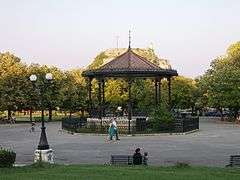
On Good Friday, from the early afternoon onward, the bands of the three Philharmonic Societies, separated into squads, accompany the Epitaph processions of the city churches. Late in the afternoon, the squads come together to form one band in order to accompany the Epitaph procession of the cathedral, while the funeral marches that the bands play differ depending on the band; the Old Philharmonic play Albinoni's Adagio, the Mantzaros play Verdi's Marcia Funebre from Don Carlo, and the Capodistria play Chopin's Funeral March and Mariani's Sventura.[79]
On Holy Saturday morning, the three city bands again take part in the Epitaph processions of St. Spyridon Cathedral in procession with the Saint's relics.[79] At this point the bands play different funeral marches, with the Mantzaros playing Miccheli's Calde Lacrime, the Palia playing Marcia Funebre from Faccio's Amleto, and the Capodistria playing the Funeral March from Beethoven's Eroica. This custom dates from the 19th century, when colonial administrators banned the participation of the British garrison band in the traditional Holy Friday funeral cortege. The defiant Corfiotes held the litany the following morning, and paraded the relics of St. Spyridon too, so that the administrators would not dare intervene.
The litany is followed by the celebration of the "Early Resurrection"; balconies in the old city are decked in bright red cloth, and Corfiotes throw down large clay pots (the bótides, μπότηδες) full of water to smash on the street pavement, especially in wider areas of Liston and in an organised fashion.[79] This is enacted in anticipation of the Resurrection of Jesus, which is to be celebrated that same night,[79] and to commemorate King David's phrase: "Thou shalt dash them in pieces like a potter's vessel" (Psalm 2:9).
Once the bótides commotion is over, the three bands parade the clay-strewn streets playing the famous "Graikoí" festive march.[80] This legendary march, the anthem of the island, was composed during Venetian rule, and its lyrics urged: "Greeks, never fear, we are all enslaved: you to the Turks, we to the Venetians, but one day we shall all be free". The Venetians were replaced by the French and the French by the British, and both the lyrics and the performance of the march were officially banned. The bands, however, defiantly played it on the Eve of Easter, as a token of the resurrection of the nation, and the tradition is honored to this day.
Musical history
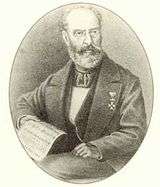
While much of present-day Greece was under Ottoman rule, the Ionian Islands enjoyed a Golden Age in music and opera. Corfu was the capital city of a prized Venetian colony and it benefited from a unique musical and theatrical heritage. Then in the 19th century, as a British Protectorate, Corfu developed a musical heritage of its own and which constitutes the nucleus of modern Greek musical history. Until the early 18th century, musical life took place in city and village squares, with performances of straight or musical comedies – known as Momaries or Bobaries. From 1720, Corfu became the possessor of the first theatre in post-1452 Greece. It was the Teatro San Giacomo (now the City Hall) named after the nearby Roman Catholic cathedral (completed in 1691).[81]
The island was also the center of the so-called Ionian School of music, the musical production of a group of Heptanesian composers, whose heyday was from the early 19th century till approximately the 1950s. It was the first school of classical music in Greece and it was a heavy influence for the later Greek music scene, after the independence.
Teatro di San Giacomo
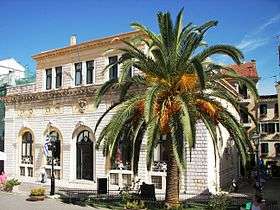
Under Venetian rule, the Corfiotes developed a fervent appreciation of Italian opera, which was the real source of the extraordinary (given conditions in the mainland of Greece) musical development of the island during this era.[82] The opera house of Corfu during 18th and 19th century was the Nobile Teatro di San Giacomo, named after the neighbouring Catholic cathedral; it was later converted into the City Hall.[82] It was both the first theatre and first opera house of Greece in modern times and the place where the first Greek opera (based on an exclusively Greek libretto), Spyridon Xyndas' The Parliamentary Candidate was performed.[82] A long series of local composers, such as Nikolaos Mantzaros, Spyridon Xyndas, Antonio Liberali, Domenico Padovani, the Zakynthian Pavlos Carrer, the Lambelet family, Spyridon Samaras, and others, all developed careers intertwined with the theatre.[82] San Giacomo's place was taken by the Municipal Theatre in 1902, which maintained the operatic tradition vividly until its destruction during German air raid in 1943.[82]
The first opera to be performed in the San Giacomo was in 1733 ("Gerone, tiranno di Siracusa"),[82] and for almost two hundred years, between 1771 and 1943, nearly every major opera from the Italian tradition, as well as many others from Greek and French composers, were performed on the stage of the San Giacomo; this tradition continues to be reflected in Corfiote operatic mythology, a fixture in famous opera singers' itineraries.[83]
Municipal Theatre of Corfu
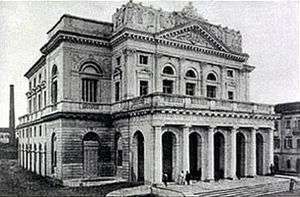
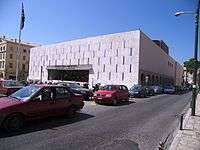
The Municipal Theatre of Corfu (Greek: Δημοτικό Θέατρο Κέρκυρας) has been the main theatre and opera house in Corfu, Greece since 1902.[84] The theatre was the successor of Nobile Teatro di San Giacomo di Corfù which became the Corfu city hall. It was destroyed during a Luftwaffe aerial bombardment in 1943.[84]
Ionian University and musical tradition
Since the early 1990s a music department has been established at the Ionian University. Aside from its academic activities, concerts in Corfu and abroad, and musicological research in the field of Neo-Hellenic Music, the Department organizes an international music academy every summer , which gathers together both international students and professors specialising in brass, strings, singing, jazz and musicology.
Ta Karnavalia
Another venerable Corfu tradition is known as the Carnival or Ta Karnavalia. Venetian in origin, festivities include a parade featuring the main attraction of Karnavalos, a rather grotesque figure with a large head and smiling face, leading a diverse procession of colourful floats.[85] Corfiots, young and old, dress up in colourful costumes and follow the parade, spilling out into the area's narrow streets (kantounia) and spreading the festivities across the city,[85] dancing and socialising. At night, in the island's more sophisticated social circles, dance and costume parties are traditional.[85]
Corfu in myth
- It is in Corfu that Hercules, just before embarking on his ten labours, slept with the naiad Melite; she bore him Hyllus, the leader of the Heraclids.[86]
- Corfu marks the Argonauts' refuge from the avenging Colchic fleet, after their seizure of the Golden Fleece.[38]
- In the mythical sea adventure of Homer's Odyssey, Kerkyra is the island of the Phaeacians, (Phaiakes) wherein Odysseus (Ulysses) meets Nausica, the daughter of King Alkinoos. The bay of Palaiokastritsa is considered to be the place where Odysseus disembarked.[87]
Corfu in literature
- British naturalist Gerald Durrell wrote three well-loved books about his 1935–1940 childhood on Corfu: My Family and Other Animals; Birds, Beasts and Relatives; and The Garden of the Gods. His brother, literary author Lawrence Durrell, also wrote a volume about Corfu: Prospero's Cell: A Guide to the Landscape and Manners of the Island of Corcyra (Corfu).
- Mary Stewart's novel This Rough Magic is set in Corfu.
- Prospero's island in Shakespeare's final play, The Tempest, is often said to have been based on Corfu.
- Humbert Humbert's first love, Annabel Leigh, is said to have "died of typhus in Corfu" in a primal scene of Vladimir Nabokov's Lolita.
Corfu in film
- Corfu was one of the main locations featured in the 1970 film The Executioner starring George Peppard and Joan Collins.[88]
- Corfu was one of the settings of The Burglars, a 1971 film starring Jean-Paul Belmondo and Omar Sharif.
- Much of the 1978 Billy Wilder film Fedora is set in Corfu and filmed on location.
- The 1981 James Bond movie For Your Eyes Only has a number of scenes filmed in Corfu. The most memorable scene of the film to be bound with the island is of the underwater ancient Greek temple, with a huge turtle swimming in front of the camera; a casino scene was also filmed at the Achilleion.[89] Other scenes filmed here include those tracing 'Melina' and James' walk through the city's streets, and Melina being greeted by Bond at Pontikonisi island. A major action element was filmed on the largest sandy beach on the island, Issos Beach in Agios Georgios South, involving a beach buggy chase along the dunes. The film's scene depicting a Greek wedding was filmed at the Bouas-Danilia traditional village (Μπούας Δανίλια παραδοσιακό χωριό).[89] Action scenes were also filmed at Neo Frourio.[90]
- The 1984 Greek film "Η Τιμή της Αγάπης" (The Price of Love), directed by Tonia Marketaki is a tragic love story taking place in Corfu. It is based on the novel Honour and Money by Konstantinos Theotokis.[91]
- Corfu is also the setting of a 1987 BBC TV series version, and a 2005 BBC movie version, of My Family and Other Animals, Gerald Durrell's book about his childhood in Corfu in the late 1930s
- The Gaze of the Gorgon (1992): a poem-film for BBC television by British poet Tony Harrison. The film examines the politics of conflict in the 20th century using the Gorgon as a metaphor. The imaginary narration of the film is done through the mouth of Jewish poet Heinrich Heine. The film describes the connection between the Corfu Gorgon at the Artemis Temple of Corfu and Kaiser Wilhelm II.[92][93] Harrison concludes his 1992 film-poem by making a proposal that in the 1994 European Union summit in Corfu, Heine's statue be returned to Corfu on time to preside over the new Europe so that EU can keep its eyes open and not turn to stone from the Gorgon's gaze.[93][94][95]
- The Countess of Corfu (Greek: Η Κόμησσα Της Κέρκυρας), a 1972 film starring Rena Vlahopoulou and Alekos Alexandrakis, was filmed in Corfu.
- ITV aired a TV series, named The Durrells, in April 2016. It is a biographical series detailing Gerald Durrell's childhood on Corfu.
Corfu in popular culture

Corfu is one of the locations in the legend of Simon and Milo, where Simon falls in love temporarily. It is the setting of the 1998 song Mediterranean Lady by Prozzak. The island is alluded to several times in David Foster Wallace's The Broom of the System. Drake mentions Corfu in a song.
Tourism
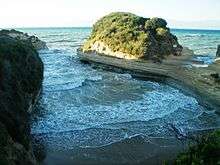
Corfiotes have a long history of hospitality to foreign residents and visitors, typified in the 20th century by Gerald Durrell's childhood reminiscence My Family and Other Animals. The north east coast has largely been developed by a few British holiday companies, with large expensive holiday villas.[96] Package holiday resorts exist on the north, east and southwest coasts.
At the other end of the island, the southern resort of Kavos also provides tourist facilities.
St George South to the west boasts the largest sandy beach on the island coupled with a selection of all inclusive package hotels and traditional corfiot villas and flats. The Korission lake nature reserve also provides a stop over for European birds migrating south.
Up until the early 20th century, it was mainly visited by the European royals and elites, including Emperor Wilhelm II of Germany and Empress Elisabeth of Austria; today it is also widely visited by middle class families (primarily from the UK, Scandinavia and Germany). With the advent of the jet airliner bringing these groups relatively affordable 'package holidays', Corfu was one of the primary destinations for this new form of mass tourism.[97] It is still popular with the ultra-wealthy however, and in the island's northeast the homeowners include members of the Rothschild family and Russian oligarchs.[98][99]
Transport
The island is linked by two motorways, GR-24 in the northwest and GR-25 in the south.
- Greek National Road 24, Cen., NW, Corfu – Palaiokastritsa
- Greek National Road 25, Cen., S, SE, Corfu – Lefkimi
Corfu has ferry services both by traditional ferries to Gaios in the island of Paxoi and as far as Patras and both traditional ferries and advanced retractable airfoil, hydrodynamic-flow, high-speed ferries called "Flying Dolphins" to Igoumenitsa and Sarandë in neighbouring Albania. The small port of Lefkimmi is also to be found at the southernmost tip of the island on Cape Kavos, offering a ferry service to the mainland.
The Ioannis Kapodistrias International Airport, named after Ioannis Kapodistrias, a distinguished Corfiot and European diplomat, and the first governor of the independent Greek state, is located around three kilometres south of Kerkyra, just half a kilometre north of Pontikonisi. The approach and landing, in a northeasterly direction, afford passengers spectacular aerial views of Pontikonisi and Vlaheraina Monastery, also taking in the hills of Kanoni, as the runway employed for landing lies a few hundred metres from these spectacular local landmarks. The airport offers domestic flights from Olympic Airlines (OA 600, 602 and 606), and Aegean Airlines (A3 402, 404 and 406). Seaplanes, Air Sea Lines, a Greek seaplane operator, offers scheduled flights from Corfu to Paxoi, Lefkada, Ithaki, Kefalonia, Ioannina, Patras and Brindisi in Italy.
The buses to the main places on the island run about six times a day between the city and Glyfada, Sidari, Paleokastritsa, Roda and Acharavi, Lefkimmi, Lefkimmi and Piri. Other coaches drive up to twice a day to Athens and Thessaloniki. City buses run through the city to the Airport, Achilleon, Gouvia, Afra, Pelekas and some other places of interest.
A bike-sharing scheme called EasyBike Brainbox is available to get around the city.[100]
Economy
Corfu is mostly planted with olive groves and vineyards and has been producing olive oil and wine since antiquity. The main wine grape varietals found in Corfu are the indigenous white Kakotrýgēs and red Petrokóritho, the Cefalonian white Robóla, the Aegean Moscháto (white muscat), the Achaean Mavrodáphnē and others.[101]
Modern times have seen the introduction of specialist cultivation supported by the mild climate, like the kumquat and bergamot oranges, which are extensively used in making spoon sweets and liqueurs. Corfu also produces local animal products, such as Corfiote graviéra (a variant of gruyere) and "Corfu" cheese (a variant of Grana); "Corfu butter" (Boútyro Kerkýras), an intensely flavored cooking and baking butter made of ewe's milk; and the noúmboulo salami made of pork and lard and flavored with orange peel, oregano, thyme and other aromatic herbs, which are also burned for smoking.
Local culinary specialties include sofrito (a veal rump roast of Venetian origin), pastitsáda (bucatini pasta served with diced veal cooked in a tomato sauce), bourdétto (cod cooked in a peppery sauce), mándoles (caramelized almonds), pastéli (honey bars made with sesame, almonds or pistacchios), mandoláto (a "pastéli" made of crushed almonds, sugar, honey and vanilla), and tzitzibíra, the local ginger beer, a remnant of the British era.
The island has again become an important port of call and has a considerable trade in olive oil. In earlier times there was a great export of citron, which was cultivated here, including for ritual use in the Jewish community during the Sukkot holiday.
International relations
Notable people
Ancient
- Arsenius (10th century) saint
- Philiscus, tragic poet, born in Corfu
- Ptolichus (5th century BC) sculptor
Modern

- H.R.H. Princess Alexia of Greece and Denmark, born in Corfu
- Marie Aspioti, M.B.E, distinguished Corfiote magazine publisher and cultural figure who influenced the literary and cultural life of post-war Corfu
- Panos Aravantinos, artist, born in Corfu
- Felice Beato, 19th-century photographer, born in Corfu
- Giacomo Casanova, lived on the island as an officer of the Venetian army
- Albert Cohen, Swiss-French author, born in Corfu
- Haim Corfu, Israeli politician, was born in Jerusalem, his family name testifying to his family's origin
- Mathew Devaris, scholar, born in Corfu
- Tommaso Diplovataccio, Greco-Italian jurist, publisher and politician, born in Corfu
- Panagiotis Doxaras, painter, pioneer of the Heptanese School of painting, worked and died in Corfu
- Gerald Durrell lived in Corfu and wrote autobiographic books about the topic of Corfu, like My Family And Other Animals, Birds, Beasts, and Relatives, The Garden of the Gods, making the island famous among the readers, books translated in many languages.
- Lawrence Durrell also lived in Corfu for some years and Lawrence wrote, among several other books on Greece, Prospero's Cell: A Guide to the Landscape and Manners of the Island of Corcyra
- Elisabeth of Bavaria ("Sissi"), Empress of Austria, built Achilleion as summer palace
- Kostas Georgakis, student, martyr of the resistance against the Greek military junta of 1967-1974, born in Corfu
- Angela Gerekou, actress, singer and politician, born in Corfu. Wife of Tolis Voskopoulos
- Spyros Gogolos, footballer, born in Corfu
- Angelos Grammenos, actor
- Augustinos Kapodistrias, younger brother of Ioannis Kapodistrias, soldier and politician. He was born in Corfu.[102]
- Ioannis Kapodistrias, first Governor of Greece, born in Corfu
- Maria Desylla-Kapodistria, relative of Ioannis Kapodistrias, mayor of Corfu and first female mayor of Greece.[54]
- Kore. Ydro., musical group, formed and based in Corfu
- Spyridon Lambros, history professor and former Prime Minister of Greece, born in Corfu
- Vicky Leandros, international pop star, born in Corfu
- Andreas Mandelis - expert on photonics, member of the Canadian Academy of Engineering. Awarded the 2014 Killam Prize
- Nikolaos Mantzaros, composer, born in Corfu
- Aristedes Metallinos, sculptor
- Margarita Miniati, (1821-1897) Greek scholar and writer, born in Corfu
- Andreas Moustoxydis, historian and philologist, born in Corfu
- Vangelis Petsalis, classical musician and composer, born in Corfu
- H.R.H. Prince Philip, Duke of Edinburgh, born Prince Philippos of Greece and Denmark, in Corfu in 1921
- Saint Philomena, according to legend she started her life as a Greek princess born in Corfu
- Iakovos Polylas, first published of Dionysios Solomos, born in Corfu
- Georgios Rallis, (1918–2006) prime minister. Son of Ioannis Rallis and Zaira, daughter of George Theotoki.
- Alexander Rossi, artist, born in Corfu
- Sakis Rouvas, singer and athlete, born in Corfu
- Reichsgraf Marshal Johann Matthias von der Schulenburg, Austrian general and aristocrat. He successfully defended the island against the Ottoman Turks during the siege of 1716 as leader of the Venetian forces in Corfu
- Spyridon Samaras, composer, born in Corfu
- Nikolaos Sophianos, humanist and cartographer, born in Corfu
- Carl Ludwig Sprenger, German botanist, lived in Corfu
- Theodore Stephanides, poet, author, doctor and naturalist, born in Corfu
- Georgios Theotokis, former Prime Minister of Greece, born in Corfu
- Ioannis Theotokis, politician, born in Corfu
- Nikephoros Theotokis (1732–1800), Greek educator and Russian archbishop, born in Corfu
- Antonio Vivaldi composer. In 1716, on commission by the republic of Venice, created the oratorio Juditha triumphans to commemorate victory over the Turks during the great siege of 1716.
- Rena Vlahopoulou, actress and singer, born in Corfu
- Eugenios Voulgaris, scholar, born in Corfu
- Sotirios Voulgaris (1857–1932), cosmetologist, founder of the Bulgari jewellery store than later became the famous Bulgari company.
- Petros Vrailas Armenis, former owner of Achilleion, born in Corfu
- Spyridon Xyndas (1812–1896) composer and musician, born in Corfu
- Kaiser Wilhelm II of Germany, bought Achilleion after Sissi's death.
- Markos Antonios Katsaitis, (1717–1787) was an 18th-century Greek scholar, geographer and lawyer born in Corfu[103]
Gallery
- Cape Drastis at the northwest tip of Corfu island
 Chalikiopoulou Lagoon (or Lake Chalikiopoulou), south of Corfu town
Chalikiopoulou Lagoon (or Lake Chalikiopoulou), south of Corfu town
 Old tower, Corfu town
Old tower, Corfu town Panorama of the Old Town of Corfu
Panorama of the Old Town of Corfu Venetian quarter, Corfu town
Venetian quarter, Corfu town Odós Ipeirou in Corfu old town
Odós Ipeirou in Corfu old town Historic building in Evgeniou Voulgareos street
Historic building in Evgeniou Voulgareos street View of St. George's Temple at the Old Fortress
View of St. George's Temple at the Old Fortress
 Gardens of Achilleion
Gardens of Achilleion.jpg) Statues at the Achilleion terrace
Statues at the Achilleion terrace Villa Rossa, landmark of Corfu city
Villa Rossa, landmark of Corfu city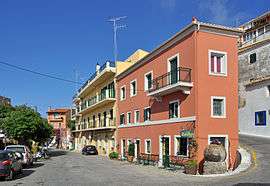 Pelekas village
Pelekas village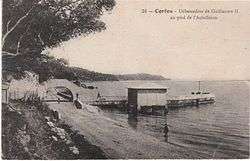 Kaiser's Bridge in Corfu ca. 1918
Kaiser's Bridge in Corfu ca. 1918
See also
- Aspioti-ELKA
- Cuisine of the Ionian islands
- Heptanese School (painting)
- Hercules (vehicles)
- Music of the Heptanese
References
-
 This article incorporates text from a publication now in the public domain: Gardner, Ernest Arthur; Caspari, Maximillian Otto Bismark (1911). "Corfu". In Chisholm, Hugh. Encyclopædia Britannica. 7 (11th ed.). Cambridge University Press.
This article incorporates text from a publication now in the public domain: Gardner, Ernest Arthur; Caspari, Maximillian Otto Bismark (1911). "Corfu". In Chisholm, Hugh. Encyclopædia Britannica. 7 (11th ed.). Cambridge University Press.
- Notes
- ↑ "Mayor of Corfu". corfu.gr.
- ↑ "Απογραφή Πληθυσμού - Κατοικιών 2011. ΜΟΝΙΜΟΣ Πληθυσμός" (in Greek). Hellenic Statistical Authority.
- 1 2 The Independent Complete Guide to Corfu
- ↑ Trevor Webster (1994). Where to Go in Greece: A New Look. 1. Settle Press. p. 221. ISBN 9781872876207.
Corfu is one of the most northern isles in Greece and also the most westerly, apart from three of its own small satellite isles...
- 1 2 "Population & housing census 2001 (incl. area and average elevation)" (PDF) (in Greek). National Statistical Service of Greece. Archived from the original (PDF) on 21 September 2015.
- 1 2 Kallikratis law Greece Ministry of Interior (Greek)
- 1 2 3 4 "Corfu City Hall website". City of Corfu. Archived from the original on 6 January 2008.
In literature, apart from the Homeric name Scheria, we meet various other names for the island, like Drepanë or Arpi, Makris, Cassopaea, Argos, Keravnia, Phaeacia, Corkyra or Kerkyra (in Doric), Gorgo or Gorgyra and much later the medieval names Corypho or Corfoi, because of the two characteristic rock-peaks of the Old Fortress of Corfu.
- 1 2 Johann Georg Keyssler (1760). Travels Through Germany, Bohemia, Hungary, Switzerland, Italy, and Lorrain: Giving a True and Just Description of the Present State of Those Countries ... G. Keith. p. 54. Retrieved 6 July 2013.
Corfu is not only a bulwark to the Venetians against the attack of a foreign enemy,... [...] ....and, since count Schulenburg caused several fortifications to be added to it, it may justly be looked upon as one of the strongest places in Europe.
- ↑ "on UNESCO World Heritage List". BBC News. 28 June 2007. Retrieved 29 June 2009.
- ↑ UNESCO Advisory Body (ICOMOS) report on Corfu History retrieved 3 July 2007
- ↑ "Old Town of Corfu on UNESCO website retrieved 3 July 2007". Whc.unesco.org. Retrieved 29 June 2009.
- ↑ Duncan Garwood, Mediterranean Europe, 2009
- ↑ Russell King, John Connell, Small worlds, global lives: islands and migration, 1999
- ↑ ANDREW MARSHALL IN CORFU (24 June 1994). "European Union Summit: Corfu summiteers ready to fudge key EU decision". The Independent.
- 1 2 3 "Greek Mythology Encyclopedia". Theoi.com. Retrieved 29 June 2009.
- 1 2 "Corfu honored with a new museum". Koine.terapad.com. Retrieved 29 June 2009.
- 1 2 "Travel to Corfu". Travel to Corfu. Retrieved 29 June 2009.
- ↑ "Mean Corfu Climatic Averages". Hellenic National Meteorological Service. Retrieved 1 March 2015.
- ↑ "Kekira Climate Normals 1961–1990". National Oceanic and Atmospheric Administration. Retrieved 1 March 2015.
- ↑ Palaeolexicon, Word study tool of ancient languages
- ↑ Strab. vi. p. 407
- ↑ W.H. Race, Apollonius Rhodius: Argonautica, Loeb Classical Library (2008), p. 409 n. 125–27; verses 4.982–992
- ↑ Cees H. Goekoop (15 September 2010). Where on Earth Is Ithaca?: A Quest for the Homeland of Odysseus. Eburon Uitgeverij B.V. p. 85. ISBN 978-90-5972-344-3. Retrieved 11 November 2012.
- ↑ Thucydides. "The Revolution in Corcyra." c. 400 BCE. Reprinted in Rogers, Perry. Aspects of Western Civilization. pp. 76–78. Pearson: Upper Saddle River. 2011.
- ↑ The Oxford Classical Dictionary, Oxford University Press, Oxford: 1992.
- ↑ Runciman, Steven (1958). The Sicilian Vespers. Cambridge: Cambridge University Press. p. 43. ISBN 978-1-107-60474-2.
- ↑ Bright Balkan morning: Romani lives & the power of music in Greek Macedonia, Charles Keil et al., 2002, p.108
- ↑ The Gypsies, Angus M. Fraser, 1995, pp. 50–51
- 1 2 The Scots Magazine and Edinburgh Literary Miscellany. 71. Archibald Constable. 1809. p. 916. Retrieved 6 July 2013.
Under the Venetians, in the middle ages, and down even to the seventeenth century, Corfu was esteemed the advanced bastion and bulwark of the Christian states, against the Ottoman power, when the Solymans and the Sclims menaced ...
- ↑ John Julius Norwich (4 December 2007). The Middle Sea: A History of the Mediterranean. Knopf Doubleday Publishing Group. p. 385. ISBN 978-0-307-38772-1. Retrieved 6 July 2013.
For Venice only a single bulwark remained: Corfu. The army that, early in 1716, the Grand Vizir flung against the citadel of Corfu consisted of 30,000 infantry and some 3,000 horse.
- ↑ Elizabeth Mary Leveson-Gower Grosvenor Westminster (2d marchioness of) (1842). Narrative of a Yacht Voyage in the Mediterranean: During 1840–41. J. Murray. p. 250. Retrieved 6 July 2013.
Corfu thus became a strong bulwark against the Turks, whose frequent attacks were successfully repulsed. In 1716 it was besieged for forty-two days by a formidable Ottoman army and fleet, and several daring attempts were made to storm ...
- ↑ Sir Richard Phillips (1822). New Voyages and Travels: Consisting of Originals, Translations, and Abridgments; with Index and Historical Preface. C. Wiley. p. 63. Retrieved 6 July 2013.
The town of Corfu, the bulwark of Italy and of the east, is Covered in all directions, towards the sea and land,
- ↑ John Knox (1767). A New Collection of Voyages, Discoveries and Travels: Containing Whatever is Worthy of Notice, in Europe, Asia, Africa and America. J. Knox. p. 203. Retrieved 6 July 2013.
Some pieces by Castiglione, deserved particular notice, together with the last siege, and the new fortifications of Corfu, which is not only painted on a picture, but curiously modelled in wood. Corfu is not only a bulwark to the Venetians, against ...
- ↑ Kenneth Meyer Setton (1991). Venice, Austria, and the Turks in the Seventeenth Century. American Philosophical Society. p. 253. ISBN 978-0-87169-192-7. Retrieved 6 July 2013.
Thus the important stronghold of Corfu was protected (according to a dispatch of Antonio Priuli, proveditor generale da ... Morea would prove to be, for they were bulwarks against the Turks' intrusion into the Adriatic.17 Corfu was apparently ...
- ↑ Henry Jervis-White-Jervis (1852). History of the island of Corfú and of the republic of the Ionian Islands. Colburn and co. p. 126. Retrieved 6 July 2013.
...sister of Sixtus-Quintus, to the Book of Gold, the Holy Father having expressed his gratitude, the Venetians represented to him that the protection of Corfu and Candia, which were the two bulwarks of Christianity, cost them more than 500,000 ...
- ↑ "The Gulf of Venice runs for 800 mi (1,287 kilometres) between Italy and Esclavonia, and at the end of it is the island of Corfu, which the Venetians call their door, although Venice is in fact 800 mi (1,287 kilometres) away." (Pedro Tafur in 1436, Andanças e viajes).
- ↑ Will Durant. The Renaissance. page 684. MJF Books. New York, 1981 ISBN 1-56731-016-8
- 1 2 3 4 5 6 7 8 9 10 "History of Corfu". Corfuweb.gr. Retrieved 29 June 2009.
- ↑ Nondas Stamatopoulos (1993). Old Corfu: history and culture. N. Stamatopoulos. pp. 164–165. Retrieved 6 April 2013.
Again, during the first great siege of Corfu by the Turks in 1537, Angelocastro ... and After a siege lasting a year the invaders were finally driven away by the defenders of the fortress who were helped by the inhabitants of the neighbouring villages. In 1571, when they once more invaded Corfu, the Turks again unsuccessfully attacked, Angelocastro, where 4,000 people had taken refuge. During the second great siege of the city by the Turks in 1716, Angelokastro once again served
- ↑ History of Corfu from xenos website
- ↑ The Cambridge Illustrated Atlas of Warfare: Renaissance to Revolution, 1492–1792. Cambridge University Press. 1996. p. 25. ISBN 978-0-521-47033-9. Retrieved 6 July 2013.
The Ottomans were a major and expanding presence in Europe, Asia, and Africa. ... The knights, their fortifications strengthened by bastions, resisted assaults and bombardment before accepting ... Ottoman naval pressure on Europe increased in the Mediterranean, with sieges of Corfu in 1537 (map 2) and Reggio in 1543.
- ↑ ca:Història de Corfú
- ↑ Serbs in Corfu website
- 1 2 3 4 5 6 History of Corfu from Corfu City Hall website Archived 6 January 2008 at the Wayback Machine.
- 1 2 United States Holocaust Memorial Museum on the Holocaust in Corfu. Also contains information about the Nazi collaborator mayor Kollas.
- ↑ From the interview of a survivor in the film "Shoah"
- 1 2 "Central Jewish Council of Greece website". Kis.gr. Archived from the original on 17 October 2007. Retrieved 29 June 2009.
- ↑ United States Holocaust Memorial Museum: "[...]two hundred of the 2,000 Corfu Jews found sanctuary with Christian families[...]"
- ↑ BBC WW2 People's War Quote: "By the time I got back to camp the troop had returned from Corfu full of stories about the wonderful reception they’d had from the locals as the liberators of the island." Bill Sanderson's Wartime Experiences -Part 4 – 40 Commando by Bill Sanderson (junior) Bill Sanderson's Wartime Experiences -Part 4 – 40 Commando by Bill Sanderson (junior) Retrieved 31 July 2008
- 1 2 JSTOR The Corfu Channel Case Quincy Wright The American Journal of International Law, Vol. 43, No. 3 (July , 1949), pp. 491–494(article consists of 4 pages) Published by: American Society of International Law Retrieved 31–07–08
- ↑ Corfu Channel Incident Records of the Admiralty, Naval Forces, Royal Marines, Coastguard, and related bodies U.K. Retrieved 31 July 2008.
- ↑ JSTOR The Corfu Channel Case: Judgment on the Preliminary Objection Harding F. Bancroft and Eric Stein Stanford Law Review, Vol. 1, No. 4 (June , 1949), pp. 646–657 (article consists of 12 pages) Published by: Stanford Law Review Retrieved 31 July 2008
- ↑ Europe since 1945 The Corfu Channel Incident By Bernard A Cook, Inc NetLibrary by Google Books Retrieved 31 July 2008
- 1 2 Municipality of Corfu from the Internet archive Quote: "In the elections of 1954 Stamatios Desillas was elected Mayor for a second term and remained in office until his death, Christmas Day 1955. Soon after a bye-election took place in Corfu in which the widow of the deceased Maria Desilla – Kapodistria, was elected Mayor with 5,365 votes in a total of 10,207. Maria Desilla became Mayor of Corfu on 15 April 1956 until 9 May 1959. She was the first female Mayor in Greece."
- ↑ Corfu General Hospital
- ↑ "Corfu Radio Station History". Tvradio.ert.gr. Retrieved 29 June 2009.
- ↑ Alfa History Quote:1995 The first in Corfu ISP by Alfa and Forthnet.
- ↑ St. George Article
- ↑ Corfu Life UK Quote: "The French were the ones who turned the Spianada into a public square and park – one of the biggest in Europe"
- ↑ Brohure of Kerkyra Quote: "SOCCER The tournament will start on Wednesday 04 of July An Open Ceremony and a parade of all the teams will take place in the biggest square in the Balkansand one of the most impressive ones in the whole continent, to the square Spianada itself which is constructed similarlyto the Royal Gardens of Europe."
- ↑ Nondas Stamatopoulos (1993). Old Corfu: history and culture. N. Stamatopoulos. p. 172.
The Palace of St. Michael and St. George (Plate III), which is generally considered the finest of the British buildings in ... seat of the Order of St. Michael and St. George which had been instituded in 1818 to honour distinguished British and local ...
- ↑ A. F. Madden (1985). Select Documents on the Constitutional History of the British Empire and Commonwealth: "The Empire of the Bretaignes," 1175–1688. Greenwood Publishing Group. pp. 690–. ISBN 978-0-313-23897-0.
- ↑ R. Winkes (editor), Kerkyra. Artifacts from the Palaiopolis, Providence 2004.
- 1 2 John C. G. Röhl (1998). Young Wilhelm: The Kaiser's Early Life, 1859–1888. Cambridge University Press. p. 297. ISBN 978-0-521-49752-7. Retrieved 4 May 2013.
After the purchase of the 'Achilleion', Kekule was invited by the Kaiser to go to Corfu to provide advice on the positioning of the ... 94 Without a doubt, Wilhelm's lifelong obsession with the statue of the Gorgon unearthed in Corfu stems from the ...
- ↑ Sherry Marker; John S. Bowman; Peter Kerasiotis (1 March 2010). Frommer's Greek Islands. John Wiley & Sons. p. 476. ISBN 978-0-470-52664-4. Retrieved 4 May 2013.
Achilles that the Kaiser had inscribed, to the Greatest Greek from the Greatest German, a sentiment removed after World War II.
- ↑ Frank Giles; Spiro Flamburiari; Fritz Von der Schulenburg (1 September 1994). Corfu: the garden isle. J. Murray in association with the Hellenic Group of Companies Ltd. p. 109. ISBN 978-1-55859-845-4. Retrieved 4 May 2013.
Although subsequently demolished in 1944 to allow the passage of a huge German coastal gun beneath, the locality still bears the name "Kaiser's Bridge".
- ↑ Corfu map: The bridge was destroyed during a German attack in World War II. The remains can still be seen today.
- ↑ "Detailed census results 1991" (PDF). Archived from the original (PDF) on 3 March 2016. (39 MB) (Greek) (French)
- ↑ History of the University
- ↑ Libraries and Museums from the City Hall website
- ↑ Frommer's Review. "Archaeological Museum". The New York Times. Retrieved 26 September 2011.
- ↑ Eleni Bistika Kathimerini Article on Ioannis Kapodistrias 22 February 2008 Quote: Η γενέτειρά του Κέρκυρα, ψύχραιμη, απολαμβάνει το προνόμιο να έχει το γοητευτικό Μουσείο Καποδίστρια στη θέση Κουκουρίσα, Translation: His birthplace, Corfu, cool, enjoys the privilege to have the charming Museum Kapodistria in the location Koukourisa and εξοχική κατοικία με τον μαγευτικό κήπο της οικογενείας Καποδίστρια, που η Μαρία Δεσύλλα – Καποδίστρια δώρισε στις τρεις κερκυραϊκές εταιρείες Translation: summer residence with the enchanting garden of the Kapodistrias family, which Maria Dessyla Kapodistria donated to the three Corfiote societies
- ↑ Robert Holland (26 January 2012). Blue-Water Empire: The British in the Mediterranean since 1800. Penguin Books Limited. p. 506. ISBN 978-1-84614-555-1.
- ↑ John Freely (30 April 2008). The Ionian Islands: Corfu, Cephalonia and Beyond. I.B.Tauris. p. 44. ISBN 978-0-85771-828-0.
- ↑ Essential Corfu. AA Publishing. 1995. p. 11. ISBN 978-0-7495-0921-7.
A dreadful storm - coupled with the rumour that St Spyridon was threatening the Turkish army with a flaming torch - broke the Turks' ...
- ↑ Michael Pratt, Lor (1978). Britain's Greek Empire: Reflections on the History of the Ionian Islands from the Fall of Byzantium. Rex Collings. p. 47. ISBN 978-0-86036-025-4.
refers to the 1716 siege, when Spyridon is meant to have frightened away the Turks;
- ↑ Dana Facaros; Michael Pauls (2007). The Greek Islands. New Holland Publishers. p. 450. ISBN 978-1-86011-325-3.
- ↑ Baroque Music As far as his theatrical activities were concerned, the end of 1716 was a high point for Vivaldi. In November, he managed to have the Ospedale della Pietà perform his first great oratorio, Juditha Triumphans devicta Holofernis barbaric [sic]. This work was an allegorical description of the victory of the Venetians (the Christians) over the Turks (the barbarians) in August 1716.
- 1 2 3 4 Corfu city hall website on Easter festivities
- ↑ As the Old Philharmonic concludes its marching in front of their building with a hearty rendition of the Graikoí March, the New Philharmonic appears and "salutes" their rivals with yet another rendition of the same march
- ↑ Corfu the Garden Isle, editor Frank Giles, John Murray 1994, ISBN 0-7195-5375-X
- 1 2 3 4 5 6 Birth of Greek opera Paper Kostas Kardamis "San Giacomo and Greek ottocento"XI Convegno Annuale di Società Italiana di Musicologia Lecce, 22–24 October 2004
- ↑ History of the theatre from Corfu cityhall
- 1 2 History of the municipal theatre from Corfu cityhall
- ↑ "Hercules slept with a minor goddess named Melite and she bore him a son named Hyllus (not to be confused with Hyllus, Hercules' son by Deianeira)". Marvunapp.com. Retrieved 29 June 2009.
- ↑ Mirror Newspaper Travel section
- ↑ The Executioner from TCM
- 1 2 "007 Fact website". 007.info. 24 June 1981. Retrieved 29 June 2009.
- ↑ imdb
- ↑ "The Price of Lave" (in Greek). Tainiothiki.
- ↑ BFI. "The Gaze of the Gorgon".
- 1 2 Merten, Karl (2004). Antike Mythen – Mythos Antike: posthumanistische Antikerezeption in der englischsprachigen Lyrik der Gegenwart. Wilhelm Fink Verlag. pp. 105–106. ISBN 978-3-7705-3871-3. Retrieved 4 May 2013.
der Räume und Kunstwerke des Achilleions hat, von entsprechendem dokumentarischem Filmmaterial begleitet.
- ↑ Pearson, Allison (4 October 1992). "Sunny side up but it's no yolk at all". The Independent. Retrieved 9 May 2013.
- ↑ Joe Kelleher (1996). Tony Harrison. Northcote House. p. 53. ISBN 978-0-7463-0789-2. Retrieved 9 May 2013.
The poem concludes with the proposal that 'to keep new Europe open-eyed/ they let the marble poet preside...'.
- ↑ Foster, Nick (11 September 2009). "Overseas Buyers Fall for Corfu's Historic Charm". The New York Times. Retrieved 30 April 2010.
- ↑ Paris Tsartas, Tourism Development in Greek Insular and Coastal Areas, 2003
- ↑ Nick Foster, Financial Times, Ionian rhapsody June 17, 2011
- ↑ Daily Telegraph, November 3, 2008
- ↑ "Easybike | Σύστημα Μίσθωσης Ποδηλάτων | Κοινόχρηστα Ποδήλατα | BikeSharing". Easybike.gr. Retrieved 12 March 2013.
- ↑ "At the time of his writing, Lambert-Gocs found 1800 hectares of vines dominated mainly by white Kakotrygis and red Petrokoritho (both cultivars having both red and white versions). Also cultivated on the island are the white Petrokoritho, Moschato Aspro, Robola and Kozanitis and the red Kakotrygis and Mavrodafni". Greekwinemakers.com. Retrieved 29 June 2009.
- ↑ "Avgoustinos Kapodistrias". Sansimera.gr. Archived from the original on 2 April 2009. Retrieved 29 June 2009.
- ↑ Bracewell, Wendy (2009). Orientations: an anthology of East European travel writing, c. 1550–2000. Central European University Press. pp. 49–50. ISBN 978-963-9776-10-4.
A Venetian Greek in the Ottoman Balkans Marco Antonio Cazzaiti, 1 742 Marco Antonio Cazzaiti (Markos Antonios Katsaites, 1717–1787) was a nobleman from Venetian Corfu, a lawyer and geographer...Greek in origin and consciousness
Further reading
- "Corfu", A Hand-book for Travellers in the Ionian Islands, Greece, Turkey, Asia Minor, and Constantinople, London: J. Murray, 1840, OCLC 397597
- "Corfu", Handbook for Travellers in Greece (7th ed.), London: John Murray, 1900
- "Corfu", Greece (4th ed.), Leipzig: Karl Baedeker, 1909
- "Corfu", The Encyclopaedia Britannica (11th ed.), New York: Encyclopaedia Britannica, 1910, OCLC 14782424
External links
- Municipality of Corfu (official site)
- Serbs in Corfu and Vido: Historical Website

.jpg)
